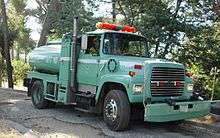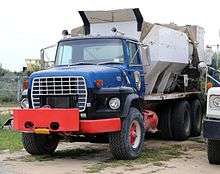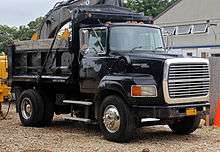Ford L-Series
| Ford L-Series Trucks | |
|---|---|
 1989 Ford LN8000 single-axle dump truck | |
| Overview | |
| Type |
Medium-duty truck Heavy-duty truck |
| Manufacturer | Ford Motor Company |
| Production | 1970 - 1998 |
| Assembly | Kentucky Truck Assembly, Louisville, Kentucky |
| Body and chassis | |
| Class | Class 6-8 truck |
| Layout | Convential cab |
| Chronology | |
| Predecessor | Ford N-Series |
| Successor | Sterling Trucks: A-Line, L-Line, Acterra |
The Ford L-Series trucks are a range of heavy-duty trucks that were built by Ford between 1970 and 1998. The first dedicated Class 8 truck produced by the company, the L-Series range replaced the N-Series short conventional (derived from the F-Series). The Louisville Line encompassed a wide range of models through the Class 7-8 GVWR ratings and for medium-duty, severe-service, and vocational applications; many were produced as semitractors. The line would become one of the most popular series of trucks Ford ever produced.[1]
History
In 1963, Ford produced its first Class 8 conventional with the introduction of the N-Series Super Duty, replacing the Super Duty models of the F-Series. While the N-Series still retained the cab of the F-Series, an all-new chassis design placed the cab much higher with a shortened hood; it shared its grille with the H-Series cabover.
By the end of the 1960s, Ford sought to modernize and streamline its heavy-truck line. Rather than adapt a light-truck architecture into a heavier-duty vehicle, a heavy-duty truck was designed from the ground up. In replacing the N-Series and the heaviest-duty models of the F-Series, Ford would introduce the L-Series range of trucks for 1970. With an all-new heavier-duty chassis, the L-Series boasted a larger cab; to improve serviceability, all models had a front-hinged hood.
For 1996, the Ford heavy-truck lines were redesigned. As the medium-duty F-Series had moved upward in size and capability during the 1980s and 1990s, the second-generation heavy-truck line was nearly exclusively for Class 8 weight ranges.
As a result of the 1996 sale of the Ford heavy-truck line to Freightliner, the L-Series/Aeromax ended production under the Ford brand, living on as the Sterling line of trucks that were produced until 2009.
The L-Series was produced in the Kentucky Truck Plant near Louisville, Kentucky, which gave rise to the nickname "Louisville Line" trucks.[1]
The nickname became so widely known that in time both Ford and Sterling would market models as "Louisville".
First generation (1970-1995)


For 1970, the L-Series was introduced in 4 size ranges, two hood lengths and grille styles, and with single or tandem (denoted by the "T" in the model designation) rear axles. Powertrains included a wide range of gasoline and diesel engines, based on GVWR.
In 1971, Ford introduced a set-back front axle configuration. For the rest of the 1970s, the L-Series saw few major changes. In 1976, the LL/LTL-9000 was introduced. Designed as a truck for long-haul drivers, the LTL-9000 was a competitor to the GMC General, Kenworth W900, Mack Super-Liner, and Peterbilt 359. Fitted with a set-forward front axle and a longer hood, this version had more room for larger powertrains. In 1978, Ford gave the LL/LTL-9000 its own grille and headlight styling, including one of the first uses of the Ford Blue Oval in North America.
Although the L-Series would see few revisions throughout its production, elements of its design would see use in other Ford vehicles. In 1974, the W-Series cabover received a larger grille similar to the chrome version on the L-Series. For 1978, the F-Series/Bronco grille was given a similar eggcrate grille pattern. In the 1980 redesign of the medium-duty F-Series, the hexagonal shape of the grille was carried over; it is a theme used in all Super Duty trucks since their 1999 introduction.
In 1984, the rest of the L-Series became one of the last North American Fords to adopt the Ford Blue Oval; as with the LTL-9000, it was placed above the grille. In 1988, the L-Series changed its grille design from an eggcrate design to that of horizontal chrome bars; the Ford Blue Oval became centered. In addition, rectangular headlights became standard in 1991.
1992 saw the introduction of the set-back front axle version of the LL/LTL-9000, designated the LLS and LTLS-9000, along with the corresponding Aeromax versions that had more aerodynamic bumpers and optional chassis skirting.
Aeromax (1988-1995)

As a response to the aerodynamic Kenworth T600, for 1988, Ford introduced its own aerodynamic semitractor. Named AeroMax L9000, the new design was an extensive upgrade of the L-9000. While sharing the same cab and the hood of the medium hood LS-9000, the Aeromax used a set-back front axle to add a form-fitting front bumper with swept front fenders. For the first time in a North American truck, automotive-style composite headlights were used. Other aerodynamic enhancements included skirted fuel tanks and a specially designed "Aero Bullet" sleeper unit. The Aeromax L9000 was one of the most aerodynamic trucks in North America upon its introduction in 1988.[2]
Following its introduction as a semitractor, the AeroMax line expanded into the vocational truck lineup alongside the rest of the Ford L-Series. A later LA-8000 was introduced for "Baby 8" intra-city delivery.
1992 saw the introduction of the extended hood, set-back front axle Aeromaxes designated LLA and LTLA-9000. These featured optional full-length chassis skirting, along with the same aero headlights and bumpers of the older medium hood LA series.
Models
The L-Series came in a total of four size ranges, designated by GVWR. As with previous Ford heavy-truck tradition, gasoline-engine trucks received a three-digit model number while diesel-engine trucks were given a four-digit model number. L-600/L-6000 and L-700/L-7000 series were Class 6/7 medium-duty trucks, typically sold as straight trucks. L-800/L-8000 trucks were Class 8 trucks, typically sold in severe-service configurations. L-900/L-9000 chassis were available in all axle configurations, but were typically sold as semitractors; the LTL-9000 was only sold with a diesel engine.
1973-1977 Models
| Model[3][4] | Max. GVWR[lower-alpha 1] | Engine[lower-alpha 2] | Trans[lower-alpha 3] |
|---|---|---|---|
| LN 600 | 24,000 lb (11,000 kg) | 361 V8 | 5M, 4A |
| LN 700/7000 | 27,500 lb (12,500 kg) | 361 V8/V175 | 10M, 4A |
| L 800/8000 | 35,000 lb (16,000 kg) | 361 V8/V175 | 13 M |
| LT 800 | 46,000 lb (21,000 kg) | 475 V8[lower-alpha 4] | 13M |
| LT 8000 | 61,000 lb (28,000 kg)[lower-alpha 5] | V-225[lower-alpha 4] | |
| L 900/9000 | 35,000 lb (16,000 kg) | 401 V8/NH230 | |
| LT 900/9000 | 61,000 lb (28,000 kg)[lower-alpha 5] | 475 V8 / 3406[lower-alpha 4] | 5x4M |
| LL 9000 | |||
| LTL 9000 | |||
| LTLS 9000[lower-alpha 6] |
Powertrain
Almost all models had at least one engine option, the 9000 Series had several. The 600-800 Series had a Ford 361 V8 standard, 700-900 had a 475 V8 optional. The 900 Series had a 401 V8 standard. In 1977 the 361 V8 was replaced by a 370 and the 401 V8 was replaced by a 429, the 475 V8 remained an option.
The 7000 and 8000 Series had a Caterpillar V175 standard, the 7000 had a V200 and the 8000 had a V225 available. The 9000 Series had a Cummins NH230 standard, Cummins N series up to 350 hp (260 kW) and Caterpillar 3406 series up to 375 hp (280 kW) were optional.
1973 engines (not all are shown.)
| Model[5] | Displacement | Type[lower-alpha 7] | Power | Torque | Notes |
|---|---|---|---|---|---|
| Ford 361 V8 | 361 cu in (5.9 l) | G V8 | 138 hp (103 kW) | 250 lb·ft (340 N·m) | Std 6/7/800 |
| Ford 401 V8 | 401 cu in (6.6 l) | G V8 | 171 hp (128 kW) | 274 lb·ft (371 N·m) | Std 900 |
| Cat. V175 | 522 cu in (8.6 l) | D V8 | 175 hp (130 kW) | 352 lb·ft (477 N·m) | Std 7/8000 |
| Cat. V225 | 636 cu in (10.4 l) | D V8 | 225 hp (168 kW) | 530 lb·ft (720 N·m) | Opt 8000 |
| Cum. NH230 | 855 cu in (14.0 l) | D I6 | 230 hp (170 kW) | Std 9000 | |
| Cum. NTC350 | 855 cu in (14.0 l) | DT I6 | 350 hp (260 kW) | Opt 9000 | |
| Cat. 3406 | 893 cu in (14.6 l) | DT I6 | 375 hp (280 kW) | 1,091 lb·ft (1,479 N·m) | Opt 9000 |
Second generation (1996-1998)


For 1996, the Ford heavy-truck lines were redesigned, the second-generation heavy-truck line was nearly exclusively for Class 8 weight ranges.
Chassis weights were increased, front axle GAWRs[lower-alpha 8] were available up to 20,000 lb (9,100 kg), single rear axles to 23,000 lb (10,000 kg) as before, and tandem rear axles to 46,000 lb (21,000 kg). On tandems a walking beam type was standard and 2 different air suspensions were available.
In the redesign, both the Aeromax and Louisville gained a wider cab with a sloping windshield. Although Aeromax models would lose their composite headlights, it gained a much larger slope to the hood. To aid ergonomics, the Aeromax and Louisville would borrow many interior controls from other Ford vehicles.
Models
As was the case previously, the heavy truck line was split into aerodynamically optimized semitractors (the newly renamed Aeromax 9500) and vocational/severe-service trucks. In the case of the latter, the popularity of the Louisville nickname led Ford to drop the L-Series nomenclature and adopt the Louisville nameplate officially.
1996 models
| Model[6] | Max. GVWR[lower-alpha 1] | Engine | Trans |
|---|---|---|---|
| LN 6000 | 35,000 lb (16,000 kg) | ||
| LN 7000 | 35,000 lb (16,000 kg) | ||
| L 8000 | 35,000 lb (16,000 kg) | mid-range | |
| LT 8000 | 64,000 lb (29,000 kg)[lower-alpha 9] | mid-range | |
| L 9000 | 35,000 lb (16,000 kg) | ||
| LT 9000 | 64,000 lb (29,000 kg)[lower-alpha 9] | ||
| LA 8000[lower-alpha 10] | 35,000 lb (16,000 kg) | mid-range | |
| LA 9000[lower-alpha 10] | 35,000 lb (16,000 kg) | ||
| LTA 9000[lower-alpha 10] | 60,000 lb (27,000 kg) | ||
| LL 9000 | 35,000 lb (16,000 kg) | ||
| LTL 9000 | 60,000 lb (27,000 kg) |
Powertrain
The second generation didn't offer gasoline or diesel V8s, all engines were inline 6 turbocharged diesels. The Caterpillar 3406 and Cummins N14 (the evolution of the NTC series) continued as heavy duty engines in the 9000 models.
1996 engines (Not all are shown)
| Model[6] | Displacement | Type[lower-alpha 11] | Power | Torque |
|---|---|---|---|---|
| Cat. 3176 | 611 cu in (10.0 l) | Mid | 250 hp (190 kW) | 975 lb·ft (1,322 N·m) |
| Cat. 3406 | 893 cu in (14.6 l) | HD E | 475 hp (354 kW) | 1,650 lb·ft (2,240 N·m) |
| Cum. L10 | 611 cu in (10.0 l) | Mid | 260 hp (190 kW) | 975 lb·ft (1,322 N·m) |
| Cum. N14 | 855 cu in (14.0 l) | HD E | 460 hp (340 kW) | 1,650 lb·ft (2,240 N·m) |
| DD Series 60 | 677 cu in (11.1 l) | E O | ||
| DD Series 60 | 775 cu in (12.7 l) | HD E O | 450 hp (340 kW) | 1,550 lb·ft (2,100 N·m) |
End of Ford production (1998)

At the end of 1996, Ford completed the sale of its heavy-truck operations, selling the rights and production tools of the Louisville, Aeromax, and Cargo to Freightliner. Ford would end production of the Louisville/Aeromax in 1998; the truck lines would re-enter production as Sterling Trucks from 1997 to 2009; both lines were produced concurrently by Ford and Freightliner during 1998.
In 1998 Sterling began production in St. Thomas, Ontario, Canada, of their L-Line 7500, 8500, 9500, and A-Line 9500. A Mercedes Benz diesel was introduced and a very low profile “CarHauler” model was developed, otherwise there was very little change between 1998 and 2008. Production ended in 2009.[7][8][9]
Notes
- 1 2 Gross Vehicle Weight Rating is the loaded weight of the truck.
- ↑ Standard engine unless noted.
- ↑ Speeds in manual(M), automatic(A).
- 1 2 3 Highest rated optional engine.
- 1 2 LNT 54,000 lb (24,000 kg) LTS 64,000 lb (29,000 kg).
- ↑ From 1992
- ↑ Gasoline (G), diesel (D), turbocharged (T), inline (I), (V), and number of cylinders.
- ↑ Gross Axle Weight Rating is the loaded weight of the axle.
- 1 2 LTS 66,000 lb (30,000 kg).
- 1 2 3 Aeromax
- ↑ Mid-range (Mid), heavy Duty (HD), electronic control (E), overhead cam (O)
References
- 1 2 1970 Ford Trucks, by Auto Editors of Consumer Guide
- ↑ 1996 Ford Trucks
- ↑ Ford L Line (sales brocure). Ford Motor Co. 1973.
- ↑ Ford L Line 600-800 Series (sales brocure). Ford Motor Co. 1977. pp. 6–7.
- ↑ Motor's Truck and Diesel Repair Manual (26 ed.). Motor. 1973. pp. 760, 763, 1066. ISBN 0-910992-16-9.
- 1 2 1996 Medium/Heavy Truck Specification Book. Ford Motor Co. 1996. p. VI-21.
- ↑ "Sterling Truck launched with three models". FleetOwner. 1 Mar 1998. Retrieved 28 Aug 2016.
- ↑ "Sterling gets Benz power". Truck News. 1 Dec 2000. Retrieved 28 Aug 2016.
- ↑ "Sterling Truck Sitemap". Daimler Truck North America. 2008. Retrieved 28 Aug 2016.
Resources
- American Truck & Bus Spotter's Guide: 1920-1985, by Tad Burness.
- Ford Trucks Since 1905, by James K. Wagner.
- Ford Heavy Duty Trucks 1948-1998, by Paul G. McLaughlin.
- Ford Truck Chronicles: by the Auto Editors of Consumers Guide.
External links
| Wikimedia Commons has media related to Ford L-Series Trucks. |
| « previous— Ford Motor Company heavy truck timeline, North American market, 1980–present | ||||||||||||||||||||||||||||||||||||||
|---|---|---|---|---|---|---|---|---|---|---|---|---|---|---|---|---|---|---|---|---|---|---|---|---|---|---|---|---|---|---|---|---|---|---|---|---|---|---|
| Type | 1980s | 1990s | 2000s | 2010s | ||||||||||||||||||||||||||||||||||
| 0 | 1 | 2 | 3 | 4 | 5 | 6 | 7 | 8 | 9 | 0 | 1 | 2 | 3 | 4 | 5 | 6 | 7 | 8 | 9 | 0 | 1 | 2 | 3 | 4 | 5 | 6 | 7 | 8 | 9 | 0 | 1 | 2 | 3 | 4 | 5 | 6 | ||
| Medium-Duty | F-Series (F-600/700/800/8000) | F-Series | F-Series Super Duty (F-650/750) | Super Duty | ||||||||||||||||||||||||||||||||||
| Conventional | L-Series/"Louisville" | Louisville | ||||||||||||||||||||||||||||||||||||
| LTL-9000 | ||||||||||||||||||||||||||||||||||||||
| Aeromax | Aeromax | |||||||||||||||||||||||||||||||||||||
| Cabover (COE) | C-Series | |||||||||||||||||||||||||||||||||||||
| Cargo | LCF | |||||||||||||||||||||||||||||||||||||
| CLT-9000 | ||||||||||||||||||||||||||||||||||||||
| Bus | B-Series (B600/B700/B800/B8000) | B-Series | ||||||||||||||||||||||||||||||||||||